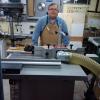Yup. I tried to focus on the things I didn't like about the G0623X (per OP's request), but it's difficult not to get all misty-eyed and giddy. Handling wide pieces is sooo much easier compared to my old saw. Need to cut a large table top to size? Set the stop, plop the top and....cut (I know it doesn't rhyme, but it's still poetry!)

Originally Posted by
Ryan Mooney

Interesting, on the Hammer the crosscut fence assembly is (effectively) an integral unit so you can slide it back and forth on the fence no problem.
OK, just so we're clear: The G0623X has a crosscut fence you can set from 90 to 45 degrees.
g0623x_det4.jpg
It also has a separate miter gauge that mounts to the sliding table:
g0623x_det8.jpg
The crosscut fence is great for longer items like picture frames, the miter gauge is better for short pieces (especially because of the built-in hold down clamp).
The G0623X takes a standard 8" dado stack, which is nice. Note that with a 3/4" wide stack, the right side of the ZCI is almost completely eaten up. There is maybe 3/16" left.
.....I can turn the saw off with my leg without releasing my hold on the work.





 Reply With Quote
Reply With Quote
 Another advantage of the homemade ones is that I make them thicker on the slider side and then bevel them to sit under the slider so they're a bit heavier duty otherwise there isn't a lot of wood left on that side when using a dado blade. I suspect the grizzly ones would not be any harder to make than the Hammer and may well be easier as the Hammer has a lot of hardware along the blade slot you have to cut little reliefs for on the underside of the ZCI.
Another advantage of the homemade ones is that I make them thicker on the slider side and then bevel them to sit under the slider so they're a bit heavier duty otherwise there isn't a lot of wood left on that side when using a dado blade. I suspect the grizzly ones would not be any harder to make than the Hammer and may well be easier as the Hammer has a lot of hardware along the blade slot you have to cut little reliefs for on the underside of the ZCI.

